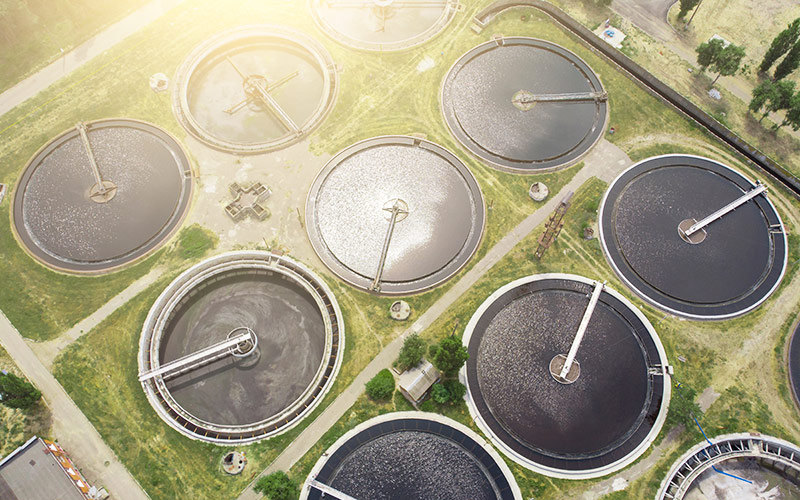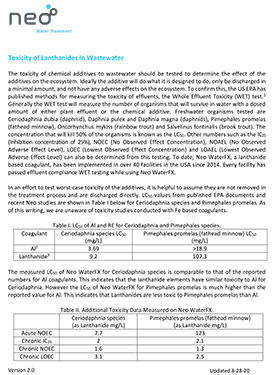The toxicity of chemical additives to wastewater should be tested to determine the effect of the additives on the ecosystem. Ideally the additive will do what it is designed to do, only be discharged in a minimal amount, and not have any adverse effects on the ecosystem. To confirm this, the US EPA has published methods for measuring the toxicity of effluents, the Whole Effluent Toxicity (WET) test.1 Generally the WET test will measure the number of organisms that will survive in water with a dosed amount of either plant effluent or the chemical additive. Freshwater organisms tested are Ceriodaphnia dubia (daphnid), Daphnia pulex and Daphnia magna (daphnids), Pimephales promelas (fathead minnow), Oncorhynchus mykiss (rainbow trout) and Salvelinus fontinalis (brook trout). The concentration that will kill 50% of the organisms is known as the LC50. Other numbers such as the IC25 (Inhibition concentration of 25%), NOEC (No Observed Effect Concentration), NOAEL (No Observed Adverse Effect Level), LOEC (Lowest Observed Effect Concentration) and LOAEL (Lowest Observed Adverse Effect Level) can also be determined from this testing. To date, Neo WaterFX, a lanthanide based coagulant, has been implemented in over 40 facilities in the USA since 2014. Every facility has passed effluent compliance WET testing while using Neo WaterFX.
In an effort to test worst‐case toxicity of the additives, it is helpful to assume they are not removed in the treatment process and are discharged directly. LC50 values from published EPA documents and recent Neo studies are shown in Table I below for Ceriodaphnia species and Pimephales promelas. As of this writing, we are unaware of toxicity studies conducted with Fe based coagulants.
Table I. LC50 of Al and RE for Ceriodaphnia and Pimephales species.
| Coagulant | Ceriodaphnia species LC50 (mg/L) | Pimephales promelas (fathead minnow) LC50(mg/L) |
| Al2 | 3.69 | >18.9 |
| Lanthanide3 | 9.2 | 107.3 |
The measured LC50 of Neo WaterFX for Ceriodaphnia species is comparable to that of the reported numbers for Al coagulants. This indicates that the lanthanide elements have similar toxicity to Al for Ceriodaphnia. However the LC50 of Neo WaterFX for Pimephales promelas is much higher than the reported value for Al. This indicates that Lanthanides are less toxic to Pimephales promelas than Al.
Table II. Additional Toxicity Data Measured on Neo WaterFX.
| Ceriodaphnia species (as Lanthanide mg/L) | Pimephales promelas (fathead minnow) (as Lanthanide mg/L) | |
| Acute NOEC | 37.7 | 123 |
| Chronic IC25 | 2 | 2.1 |
| Chronic NOEC | 1.6 | 1.3 |
| Chronic LOEC | 3.1 | 2.5 |
The effluent from plants using Neo WaterFX has been tested for residual lanthanide elements. The concentration in the effluent is expected to increase based on dose. Table III shows the dose rate of Neo WaterFX and the measured concentration in the effluent. This data shows in plants that have a filtration system like a membrane bioreactor (MBR) or in a typical aeration basin followed by a clarifier the lanthanide concentration is quite low and significantly lower than the LC50. In the listed lagoon system which doesn’t have a filter the effluent lanthanide concentration is slightly higher but well below the LC50 and the other parameters measured.
Table III. Effluent Lanthanide Concentrations.
| Plant Type | Neo WaterFX dose (μL/L) | Effluent Lanthanide Conc. (mg/L) |
| MBR Plant 1 | 20 | 0.017 |
| Lagoon (no filter) | 36 | 0.37 |
| Aeration Basin/clarifier | 16 | 0.050 |
The insoluble material generated (sludge) from lanthanide addition to wastewater has also been tested. The typical concentration of lanthanide chloride in Neo WaterFX is 648 g/L as CeCl3, applied at a volumetric dosage rate of 1:53,000, yields approximately 12 mg REPO4/L (RE represents a lanthanide). This value is lower than the conservatively calculated safe limit of 14 mg REPO4/L for drinking water.4 The treated water is then further processed through a solids/liquid separation system such as a clarifier or filter. Any lanthanide solids that precipitate would therefore be removed, with the actual lanthanide phosphate concentration likely to be much lower than 12 mg/L at the point of discharge.5 The primary potential for human exposure to Neo WaterFX treated water would be through consumption of treated water, whereas aquatic organisms could be exposed at any point after treatment of the water body. Thus, little to no harmful effects are expected from solids generated.
Generally lanthanides have a low toxicity rating.6,7 There are no known human toxicity studies of cerium phosphate. However, lanthanum carbonate, a commonly used human drug for kidney disease, has been extensively studied.8 In the acidic mammalian gastrointestinal tract, lanthanum carbonate breaks down and combines with phosphate to form lanthanum phosphate, thus ultimately removing the phosphate from the human body. This process is similar to the way Neo WaterFX removes phosphate from water bodies. Therefore, the extensive human and animal studies of lanthanum carbonate also address the final lanthanum product in the human body, namely lanthanum phosphate.
Lanthanum carbonate, and therefore lanthanum phosphate, has very low toxicity in humans and animals. There is no indication that lanthanum phosphate is genotoxic (causes cancer or other significant health problems).9 In a bioassay to determine potential genotoxicity, the major component of Neo WaterFX, cerium chloride, was found to rapidly form cerium phosphate in the biological system and, like lanthanum phosphate, was not genotoxic. Given the similar chemistry and environmental behavior of lanthanum phosphate and cerium phosphate, there is no reason to believe that cerium phosphate would have different toxicity and should be considered non‐toxic for humans at the low concentrations likely to be encountered in water treated with RE technology.
The toxicity of the sludge generated towards denitrification bacteria has also been studied in unpublished sludge respiration inhibition studies. The lanthanide solids present in the sludge would be those discussed earlier such as REPO4, RE2(CO3)3, and RE(OH)3. A study conducted by Intrinsic Technologies for Neo found no toxicity towards activated sludge microbes. As a comparison, for CeO2 the EC50 for inhibition of respiration was greater than 1000 mg/L.10 Based on this the addition of lanthanides to wastewater treatment should have no effect on the microbes.
Neo has also evaluated the effect of land applying the sludge generated in treatment plants using lanthanide based coagulants. This study was performed by Richard Wolkowski, Ph.D. (Extension Soil Scientist at University of Wisconsin‐Madison) at Alfisol Soil Management, LLC. In this study, P availability to corn from rare earth biosolids was investigated and compared to P availability from a commercial P fertilizer and ferric biosolids. Corn was chosen for the study as it is the most common crop treated with biosolids and is grown on four million acres in Wisconsin. Lanthanide biosolids produced soil with P availability between P fertilizer and ferric biosolids as measured by the change in soil test P. The corn whole‐plant dry matter yield either was unaffected by the rare earth biosolids. Thus, the application of lanthanide biosolids is not expected to affect the growth and yield of corn when applied at normal rates that supply the corn N requirement.
2 Ambient Aquatic Life Water Quality For Aluminum‐ 1988 EPA‐440/5‐86‐008
3 Unpublished data from Neo Chemicals & Oxides on Neo WaterFX and converted to a Lanthanide element basis. LC50 for ceriodaphnia dubia is 48 hr and for pimephales promelas is 96 hr.
4 The oral reference dose for the similar compound Lanthanum Phosphate is 0.5 mg/kg‐day (NSF International 2010 as cited by United States Environmental Protection Agency (USEPA). 2012. Rare earth elements: A review of production, processing, recycling, and associated environmental issues. EPA/600/R‐12/5721. August.). Thus the safe daily exposure level of a rare earth phosphate is 0.5 mg/kg‐day * 70 kg = 35 mg/day (assuming a 70 kg person). Using the 80% upper ceiling (United States Environmental Protection Agency (USEPA). 2000. Methodology for deriving ambient water quality criteria for the protection of human health. Office of Water, EPA‐822‐B‐00‐004. October. Available online: https://water.epa.gov/scitech/swguidance/standards/upload/2005_05_06_criteria_humanhealth_method_complete.pd
f) contaminant exposure from water the safe concentration is 0.5 mg/kg‐day * 70 kg * 0.8/(2 L/day consumed) = 14 mg/L.
5 REPO4 will be detected in a total phosphorus test. Assuming all 12 mg/L REPO4 was discharged, the TP measured would be 1.6 mg P/L, which is much higher than new discharge permits coming into effect (<1 or <0.1).
6 Kilbourn, B. T. Cerium: A Guide to Its Role in Chemical Technology. Molycorp, Inc.: Fairfield, NJ, 1992.
7 Haley, T. J. Pharmacology and Toxicology of the Rare Earth Elements. J. Pharm. Sc, 1965, 54, 663.
8 For references see
- Food and Drug Administration (FDA). 2004. Review and Evaluation of New Toxicology Data Submitted with Fosrenol® NDA Resubmission (NDA 21‐468). Available online: https://www.accessdata.fda.gov/drugsatfda_docs/nda/2004/21‐468_Fosrenol_Pharmr.pdf
- Hutchison, A.J., et al. 2009. Lanthanum carbonate treatment, for up to 6 years, is not associated with adverse effects on the liver in patients with chronic kidney disease Stage 5 receiving hemodialysis. Clin Nephrol. 71:286‐ 95.
- Finn, W.F., et al. 2005. A long‐term, open‐label extension study on the safety of treatment with lanthanum carbonate, a new phosphate binder, in patients receiving hemodialysis. Curr Med Res Opin. 21:657‐64.
9 ANOHSC (Australian National Occupational Health and Safety Commission). 1998. Available online: https://www.nicnas.gov.au/ data/assets/word_doc/0015/20175/NA606FR.docx.
10 Toxicological Review of Nano Cerium Oxide. Prospect 2010




